1. 주요 레이어
- Conv2D
- tensorflow.keras.layers.Conv2D
- tf.nn.conv2d
import tensorflow as tf
from tensorflow.keras.layers import Conv2D
import matplotlib.pyplot as plt
import numpy as np
from sklearn.datasets import load_sample_image
china = load_sample_image('china.jpg') / 255.
print(china.dtype)
print(china.shape)
# 출력 결과
float64
(427, 640, 3)
plt.imshow(china)
plt.show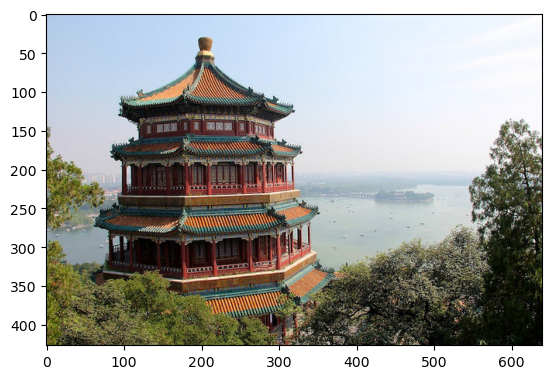
flower = load_sample_image('flower.jpg') / 255.
print(flower.dtype)
print(flower.shape)
# 출력 결과
float64
(427, 640, 3)
plt.imshow(flower)
plt.show()
images = np.array([china, flower])
batch_size, height, width, channels = images.shape
print(images.shape)
# 출력 결과
(2, 427, 640, 3)# 필터 적용
filters = np.zeros(shape = (7, 7, channels, 2), dtype = np.float32)
# 수직선 추가
filters[:, 3, :, 0] = 1
# 수평선 추가
filters[3, :, :, 1] = 1
print(filters.shape)
# 출력 결과
(7, 7, 3, 2)# 텐서플로우로 conv2d 사용하는 방법
outputs = tf.nn.conv2d(images, filters, strides = 1, padding = 'SAME')
print(outputs.shape)
plt.imshow(outputs[0, :, :, 1], cmap = 'gray')
plt.show()
# 출력 결과
(2, 427, 640, 2)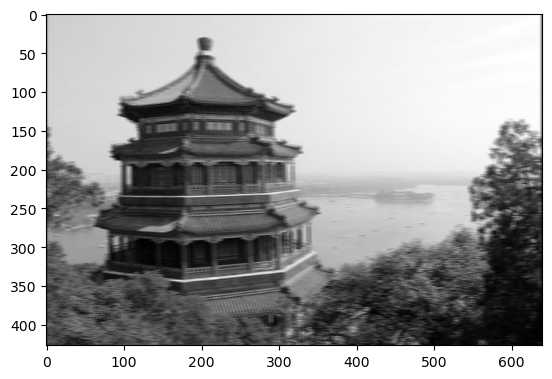
plt.imshow(outputs[0, :, :, 0], cmap = 'gray')
plt.show()
# keras로 conv2d 사용하는 방법
conv = Conv2D(filters = 32, kernel_size = 3, strides = 1,
padding = 'same', activation = 'relu')
- MaxPool2D
- 텐서플로우 저수준 딥러닝 API
- tf.nn.max_pool
- 사용자가 사이즈를 맞춰줘야함
- keras의 모델의 층으로 사용하고 싶으면 Lambda 층으로 감싸줘야함
- Keras 고수준 API
- keras.layers.MaxPool2D
import tensorflow as tf
from tensorflow.keras.layers import MaxPool2D, Lambda
output = tf.nn.max_pool(images,
ksize = (1, 1, 1, 3),
strides = (1, 1, 1, 3),
padding = 'VALID')
# 텐서플로우에서 max pool 사용하는 방법
output_keras = Lambda(
lambda X: tf.nn.maxpool(X, ksize = (1, 1, 1, 3), strides = (1, 1, 1, 3), padding = 'VALID')
)
# 케라스에서 max pool 사용하는 방법
max_pool = MaxPool2D(pool_size = 2)flower = load_sample_image('flower.jpg') / 255.
print(flower.dtype)
print(flower.shape)
# 출력 결과
float64
(427, 640, 3)
# 차원 추가
flower = np.expand_dims(flower, axis = 0)
flower.shape
# 출력 결과
(1, 427, 640, 3)
# pool size를 2로 maxpool 적용으로 데이터 수는 1/2
output = Conv2D(filters = 32, kernel_size = 3, strides = 1, padding = 'SAME', activation = 'relu')(flower)
output = MaxPool2D(pool_size = 2)(output)
output.shape
# 출력 결과
TensorShape([1, 213, 320, 32])plt.imshow(output[0, :, :, 8], cmap = 'gray')
plt.show()
- AvgPool2D
- 텐서플로우 저수준 딥러닝 API
- tf.nn.avg_pool
- 케라스 고수준 API
- keras.layers.AvgPool2D
from tensorflow.keras.layers import AvgPool2D
# 원본
flower.shape
# 출력 결과
(1, 427, 640, 3)
# AvgPool 적용(데이터 크기 1/2)
output = Conv2D(filters = 32, kernel_size = 3, strides = 1, padding = 'SAME', activation = 'relu')(flower)
output = AvgPool2D(pool_size = 2)(output)
output.shape
# 출력 결과
TensorShape([1, 213, 320, 32])plt.imshow(output[0, :, : , 8], cmap = 'gray')
plt.show()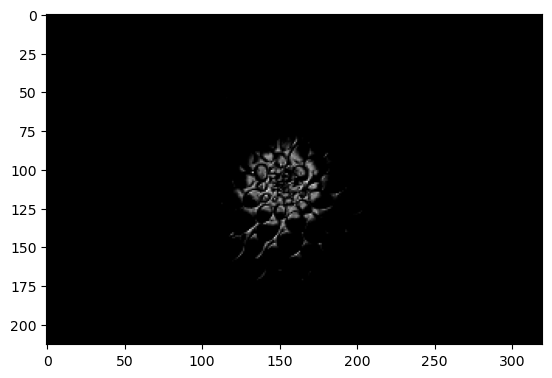
- GlobalAvgPool2D(전역 평균 풀링 층)
- keras.layers.GlobalAvgPool2D()
- 특징 맵 각각의 평균값을 출력하는 것이므로, 특성맵에 있는 대부분의 정보를 잃음
- 출력층에는 유용할 수 있음
from tensorflow.keras.layers import GlobalAvgPool2D
output = Conv2D(filters = 32, kernel_size= 3, strides = 1, padding = 'SAME', activation = 'relu')(flower)
output = GlobalAvgPool2D()(output)
output.shape
# 출력 결과
TensorShape([1, 32])
2. 예제로 보는 CNN 구조와 학습
● 일반적인 구조
- modules import
%load_ext tensorboard
import datetime
import numpy as np
import tensorflow as tf
import matplotlib.pyplot as plt
from tensorflow.keras import Model
from tensorflow.keras.models import Sequential
from tensorflow.keras.layers import Dense, Flatten, Conv2D, MaxPool2D, AvgPool2D, Dropout
from tensorflow.keras import datasets
from tensorflow.keras.utils import to_categorical, plot_model
- 데이터 로드 및 전처리
(x_train, y_train), (x_test, y_test) = datasets.fashion_mnist.load_data()
# 원본 데이터 형태
print(x_train.shape)
print(y_train.shape)
print(x_test.shape)
print(y_test.shape)
# 출력 결과
(60000, 28, 28)
(60000,)
(10000, 28, 28)
(10000,)
# x 데이터에 축 하나씩 추가
x_train = x_train[:, :, :, np.newaxis]
x_test = x_test[:, :, :, np.newaxis]
print(x_train.shape)
print(x_test.shape)
# 출력 결과
(60000, 28, 28, 1)
(10000, 28, 28, 1)
# y 데이터 카테고리화
num_classes = 10
y_train = to_categorical(y_train, num_classes)
y_test = to_categorical(y_test, num_classes)
print(y_train.shape)
print(y_test.shape)
# 출력 결과
print(y_train.shape)
print(y_test.shape)
# x 데이터 표준화
x_train = x_train.astype('float32')
x_test = x_test.astype('float32')
x_train /= 255.
x_test /= 255.
- CNN을 위한 간단한 모델
def build():
model = Sequential([Conv2D(64, 7, activation = 'relu', padding = 'same', input_shape = [28, 28, 1]),
MaxPool2D(pool_size = 2),
Conv2D(128, 3, activation = 'relu', padding = 'same'),
MaxPool2D(pool_size = 2),
Conv2D(256, 3, activation = 'relu', padding = 'SAME'),
MaxPool2D(pool_size = 2),
Flatten(),
Dense(128, activation = 'relu'),
Dropout(0.5),
Dense(64, activation = 'relu'),
Dropout(0.5),
Dense(10, activation = 'softmax')])
return model
- 모델 컴파일
model = build()
model.compile(optimizer = 'adam',
loss = 'categorical_crossentropy',
metrics = ['accuracy'])model.summary()
# 출력 결과
Model: "sequential_2"
_________________________________________________________________
Layer (type) Output Shape Param #
=================================================================
conv2d_11 (Conv2D) (None, 28, 28, 64) 3200
max_pooling2d_9 (MaxPooling (None, 14, 14, 64) 0
2D)
conv2d_12 (Conv2D) (None, 14, 14, 128) 73856
max_pooling2d_10 (MaxPoolin (None, 7, 7, 128) 0
g2D)
conv2d_13 (Conv2D) (None, 7, 7, 256) 295168
max_pooling2d_11 (MaxPoolin (None, 3, 3, 256) 0
g2D)
flatten_2 (Flatten) (None, 2304) 0
dense_6 (Dense) (None, 128) 295040
dropout_4 (Dropout) (None, 128) 0
dense_7 (Dense) (None, 64) 8256
dropout_5 (Dropout) (None, 64) 0
dense_8 (Dense) (None, 10) 650
=================================================================
Total params: 676,170
Trainable params: 676,170
Non-trainable params: 0
_________________________________________________________________plot_model(model)
- Hyper Parameters
callbacks = [tf.keras.callbacks.TensorBoard(log_dir = './logs')]
EPOCHS = 20
BATCH_SIZE = 200
VERBOSE = 1
- 모델 학습(GPU 추천)
- validation_split을 통해 검증 데이터셋을 생성
hist = model.fit(x_train, y_train,
epochs = EPOCHS,
batch_size = BATCH_SIZE,
validation_split = 0.3,
callbacks = callbacks,
verbose = VERBOSE)
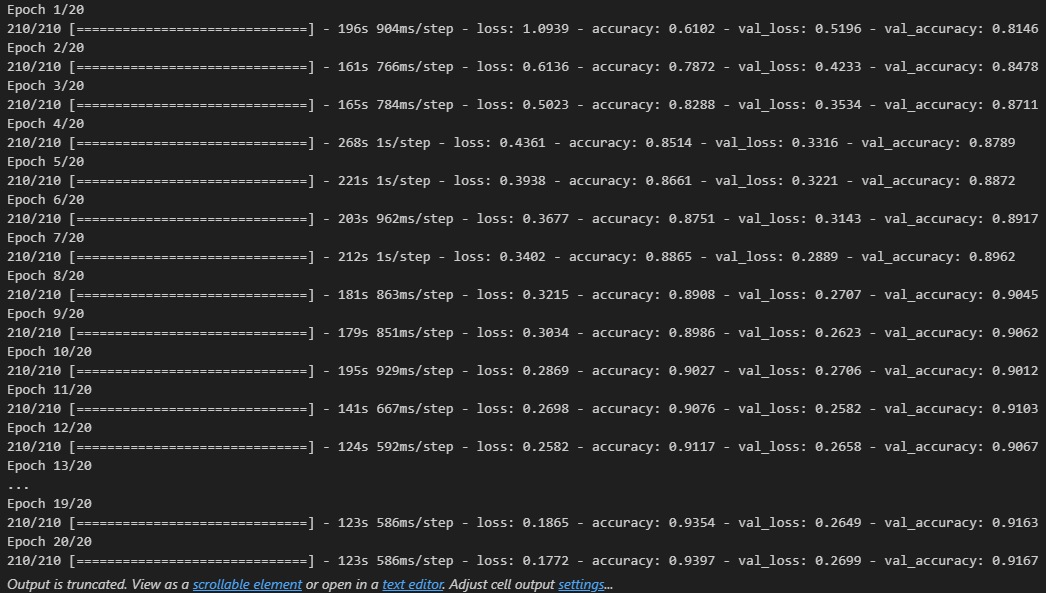
- 텐서보드로 확인
log_dir = '.logs' + datetime.datetime.now().strftime('%Y%m%d-%H%M%S')
%tensorboard --logdir logs/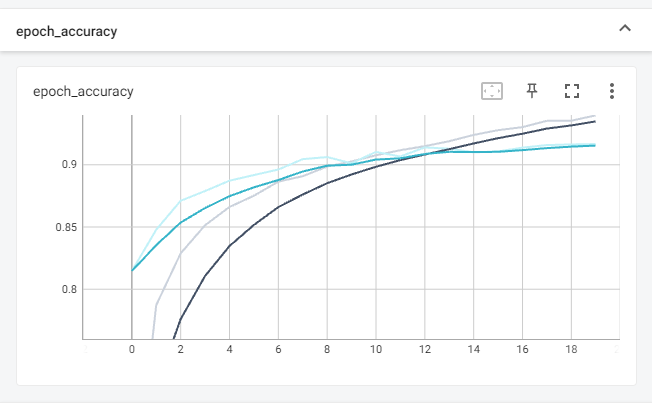


● LeNet-5(코드 출처: https://datahacker.rs/lenet-5-implementation-tensorflow-2-0/)
- CNN의 초창기 모델
- 필기체 인식을 위한 모델
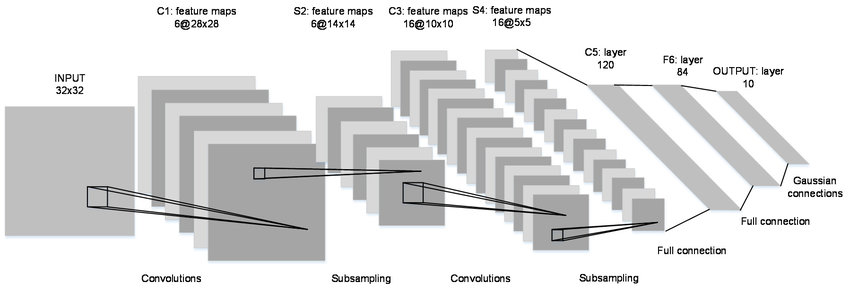
- modules import
import datetime
import numpy as np
import tensorflow as tf
import matplotlib.pyplot as plt
from tensorflow.keras import Model
from tensorflow.keras.models import Sequential
from tensorflow.keras.layers import Dense, Flatten, Conv2D, MaxPool2D, AvgPool2D, Dropout
from tensorflow.keras import datasets
from tensorflow.keras.utils import to_categorical, plot_model
from sklearn.model_selection import train_test_split
- 데이터 로드 및 전처리
(x_train_full, y_train_full), (x_test, y_test) = datasets.mnist.load_data()
x_train, x_val ,y_train, y_val = train_test_split(x_train_full, y_train_full, test_size = 0.3, random_state = 777)
x_train = x_train[..., np.newaxis]
x_val = x_val[..., np.newaxis]
x_test = x_test[..., np.newaxis]
num_classes = 10
y_train = to_categorical(y_train, num_classes)
y_val = to_categorical(y_val, num_classes)
y_test = to_categorical(y_test, num_classes)
x_train = x_train.astype('float32')
x_val = x_val.astype('float32')
x_test = x_test.astype('float32')
x_train /= 255.
x_val /= 255.
x_test /= 255.
print(x_train.shape)
print(y_train.shape)
print(x_val.shape)
print(y_val.shape)
print(x_test.shape)
print(y_test.shape)
# 출력 결과
(42000, 28, 28, 1)
(42000, 10)
(18000, 28, 28, 1)
(18000, 10)
(10000, 28, 28, 1)
(10000, 10)
- 모델 구성 및 컴파일
class LeNet(Sequential):
def __init__(self, input_shape, nb_classes):
super().__init__()
self.add(Conv2D(6, kernel_size = (5, 5), strides = (1, 1), activation = 'tanh', input_shape = input_shape, padding = 'SAME'))
self.add(AvgPool2D(pool_size = (2, 2), strides = (2, 2), padding = 'valid'))
self.add(Conv2D(16, kernel_size = (5, 5), strides = (1, 1), axtivation = 'tanh', padding = 'valid'))
self.sdd(AvgPool2D(pool_size = (2, 2), strides = (2, 2), padding = 'valid'))
self.add(Flatten())
self.add(Dense(120, activation = 'tanh'))
self.add(Dense(84, activation = 'tanh'))
self.add(Dense(nb_classes, activation = 'softmax'))
self.compile(optimizer = 'adam',
loss = 'categorical_crossentropy',
metrics = ['accuracy'])
model = LeNet(input_shape = (28, 28, 1), nb_classes = 10)
model.summary()
# 출력 결과
Model: "le_net_2"
_________________________________________________________________
Layer (type) Output Shape Param #
=================================================================
conv2d_17 (Conv2D) (None, 28, 28, 6) 156
average_pooling2d_3 (Averag (None, 14, 14, 6) 0
ePooling2D)
conv2d_18 (Conv2D) (None, 10, 10, 16) 2416
average_pooling2d_4 (Averag (None, 5, 5, 16) 0
ePooling2D)
flatten_3 (Flatten) (None, 400) 0
dense_9 (Dense) (None, 120) 48120
dense_10 (Dense) (None, 84) 10164
dense_11 (Dense) (None, 10) 850
=================================================================
Total params: 61,706
Trainable params: 61,706
Non-trainable params: 0
_________________________________________________________________plot_model(model, show_shapes = True)
- Hyper Parameters
EPOCHS = 20
BATHC_SIZE = 128
VERBOSE = 1
- 모델 학습
hist = model.fit(x_train, y_train,
epochs = EPOCHS,
batch_size = BATCH_SIZE,
validation_data = (x_val, y_val),
verbose = VERBOSE)
- 학습 결과 시각화
plt.figure(figsize = (12, 6))
plt.subplot(1, 2, 1)
plt.plot(hist.history['loss'], 'b-', label = 'loss')
plt.plot(hist.history['val_loss'], 'm--', label = 'val_loss')
plt.xlabel('Epochs')
plt.grid()
plt.legend()
plt.subplot(1, 2, 2)
plt.plot(hist.history['accuracy'], 'g-', label = 'accuracy')
plt.plot(hist.history['val_accuracy'], 'r-', label = 'val_accuracy')
plt.xlabel('Epochs')
plt.grid()
plt.legend()
plt.show()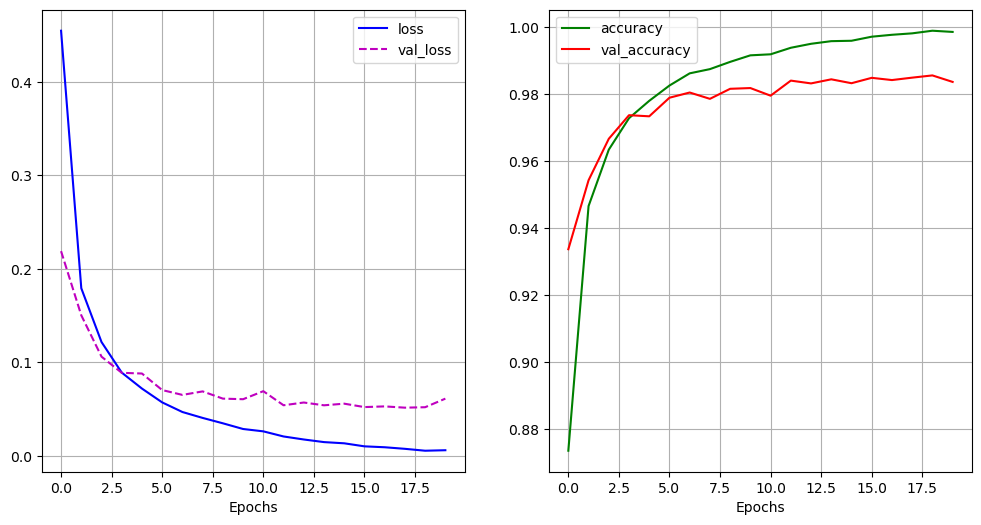
- 모델 평가
model.evaluate(x_test, y_test)
# 출력 결과
313/313 [==============================] - 3s 7ms/step - loss: 0.0564 - accuracy: 0.9854
[0.0564129501581192, 0.9854000210762024]'Python > Deep Learning' 카테고리의 다른 글
| [딥러닝-케라스] 케라스 CIFAR10 CNN 모델 (0) | 2023.05.16 |
|---|---|
| [딥러닝-케라스] 케라스 Fashion MNIST CNN 모델 (0) | 2023.05.14 |
| [딥러닝-텐서플로우] 텐서플로우 Data API (1) | 2023.05.12 |
| [딥러닝-케라스] 케라스의 다양한 학습 기술 (0) | 2023.05.11 |
| [딥러닝-케라스] 케라스 Fashion MNIST 모델 (0) | 2023.05.08 |